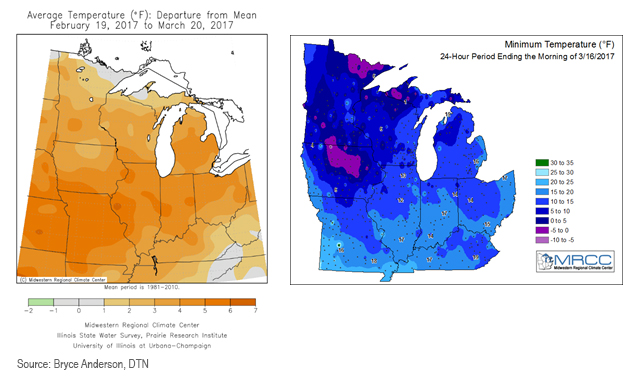Warm weather early in the year followed by below-freezing temperatures led to a lot of speculation about possible winter wheat losses, especially in soft red winter (SRW) areas.
However, our crop insurance officers say they have heard more concern in eastern Kansas about drought and possible disease pressure than freeze damage. Agronomists say damage to SRW may result in some insurance claims, especially Kentucky, but likely was not large enough to affect market prices.
Here is some perspective. Bryce Anderson, senior ag meteorologist for DTN/The Progressive Farmer, provided two temperature maps: the warmer-than-average weather (in yellow) for a portion of the affected area for February 19-March 20, which brought wheat out of dormancy in some areas, and the low temperatures (in blue) that hit March 15 and 16.

Soft Red Winter
“Soft red winter in this area may have been injured,” said Charles Mansfield, Purdue University Extension agronomist based in Vincennes, Ind. “Some wheat fields in southern Indiana and many in Kentucky were already jointing when low temperatures dipped into the teens or even single-digits in mid-March. While there are some fields with significant injury – especially in Kentucky -- early observations indicate injury is not as bad as would have been predicted.”
Varying levels of damage likely also occurred in Arkansas, according to Jason Kelley, wheat and feed grains extension agronomist at the University of Arkansas.
“Stages of growth ranged considerably across the state, but in most areas where temperatures dropped below the 28-degree threshold, wheat was in the Feekes 7 to 8 growth stage,” far enough along for damage to the growing point to be likely, he said.
Hard Red Winter
In Kansas, a March 17 agronomy update noted that temperatures from March 8 to 14 were somewhat below average for the central portion of the state but above normal in the western portion.
“While the western third of the state had temperatures below the damage threshold for jointed wheat, the majority of the fields in that region are not yet at that stage,” according to Romulo Lollato, extension wheat and forages specialist, who noted some leaf tip dieback has occurred in parts of the state. “In regions where the crop was more developed, such as south-central and southeast Kansas, temperatures did not reach low enough long enough to damage the growing point.”
In Kansas and Nebraska, moisture and wind are of greater concern right now, according to crop insurance officers for Frontier Farm Credit and Farm Credit Services of America (FCSAmerica). “Rust is going to be the issue most talked about this year,” said Darrin Clarkson, vice president of insurance in FCSAmerica’s Scottsbluff, Neb., office.
Wheat streak mosaic virus is a threat as well, as are aphids and wheat curl mites, Lollato said.
“Because wheat streak mosaic virus is untreatable and decimates crops, it may lead to abandonment this spring,” Lollato said.
Market Impact
An estimated 10 percent of the SRW area was at risk of damage from the mid-March freeze. Even if all that wheat went unharvested – unlikely as of this point – global and U.S. supplies would be sufficient to avoid a major price run up. USDA estimates SRW ending stocks for 2016/17 at 220 million bushels, slightly above last year. The stocks/use ratio is a heavy 68.8 percent. If the crop fell 10 percent, or 34.5 million bushels, and stocks fell by the same amount to 186.4 million bu., the ratio would drop to 58.1 percent -- still more than ample.
HRW supply/demand balance tells a similar story, with the stocks/use ratio at 58.6 percent based on USDA’s ending stocks estimate of 566.2 million bushels.
Of course, winter wheat is not yet past the frost free date, so the jury is still out.

